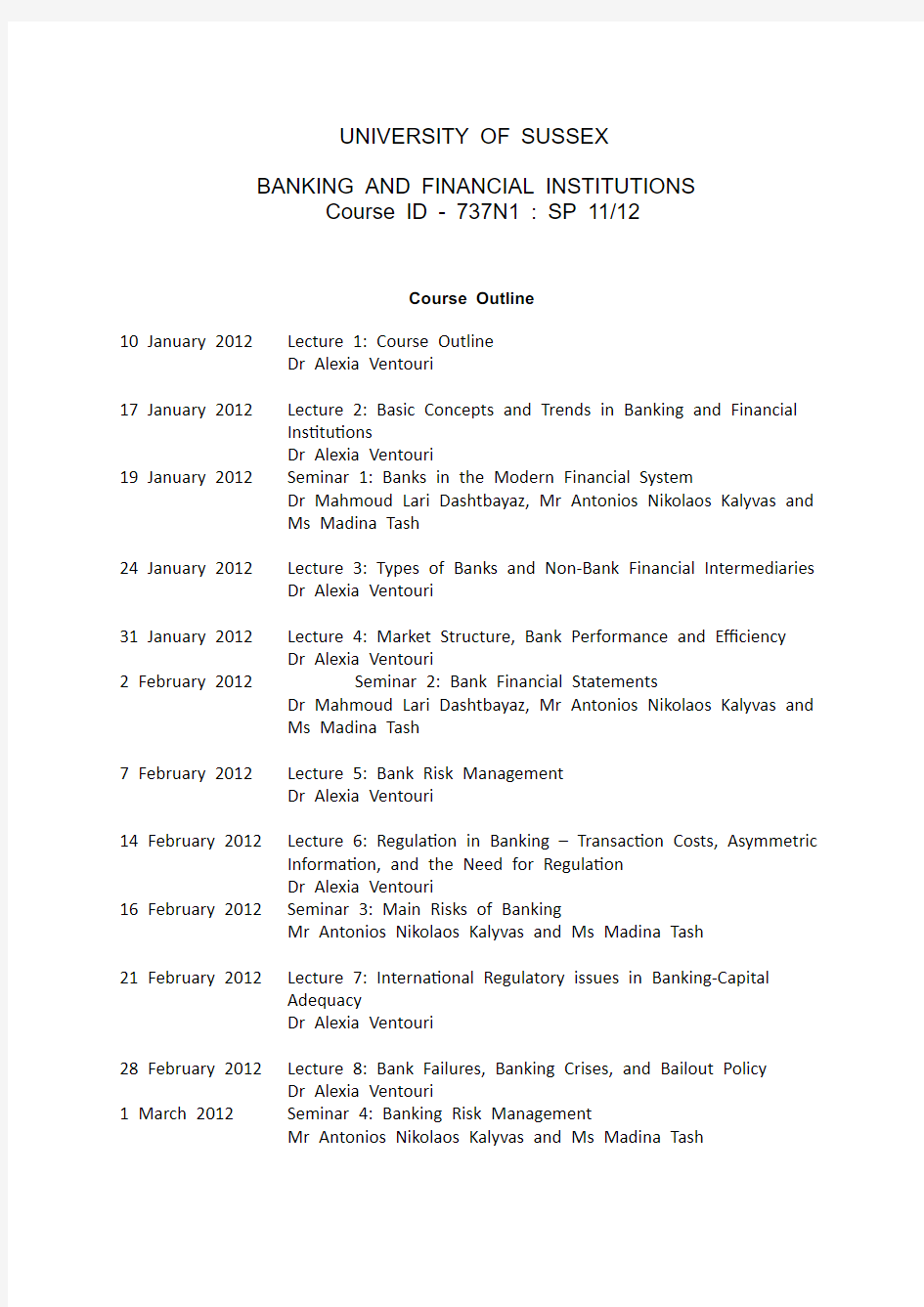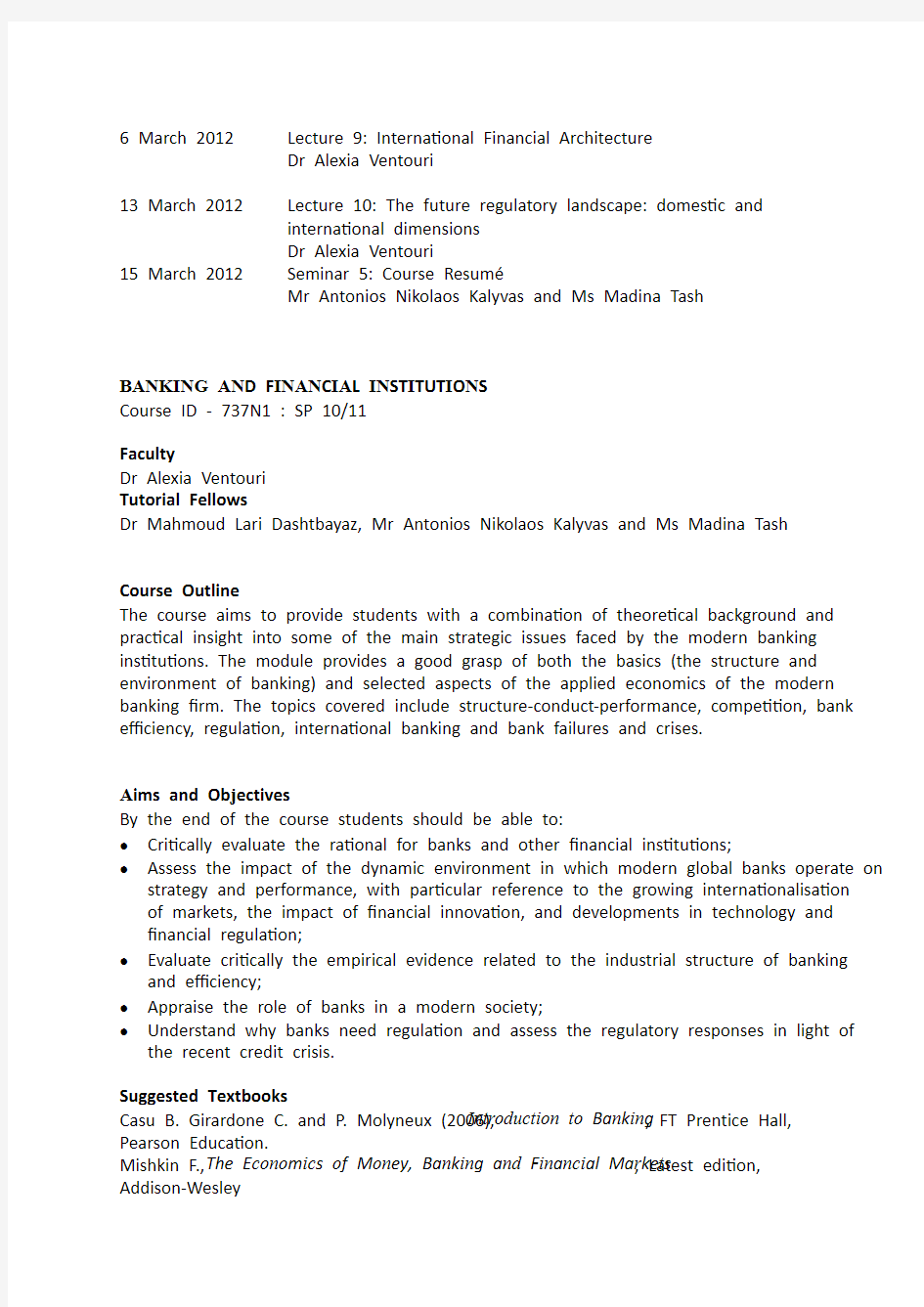Outline_Banking_and_Financial_Institutions


UNIVERSITY OF SUSSEX
BANKING AND FINANCIAL INSTITUTIONS
Course ID - 737N1 : SP 11/12
Course Outline
10 January 2012 Lecture 1: Course Outline
Dr Alexia Ventouri
17 January 2012 Lecture 2: Basic Concepts and Trends in Banking and Financial
Institutions
Dr Alexia Ventouri
19 January 2012 Seminar 1: Banks in the Modern Financial System
Dr Mahmoud Lari Dashtbayaz, Mr Antonios Nikolaos Kalyvas and
Ms Madina Tash
24 January 2012 Lecture 3: Types of Banks and Non-Bank Financial Intermediaries
Dr Alexia Ventouri
31 January 2012 Lecture 4: Market Structure, Bank Performance and Efficiency
Dr Alexia Ventouri
2 February 2012 Seminar 2: Bank Financial Statements
Dr Mahmoud Lari Dashtbayaz, Mr Antonios Nikolaos Kalyvas and
Ms Madina Tash
7 February 2012 Lecture 5: Bank Risk Management
Dr Alexia Ventouri
14 February 2012 Lecture 6: Regulation in Banking – Transaction Costs, Asymmetric
Information, and the Need for Regulation
Dr Alexia Ventouri
16 February 2012 Seminar 3: Main Risks of Banking
Mr Antonios Nikolaos Kalyvas and Ms Madina Tash
21 February 2012 Lecture 7: International Regulatory issues in Banking-Capital
Adequacy
Dr Alexia Ventouri
28 February 2012 Lecture 8: Bank Failures, Banking Crises, and Bailout Policy
Dr Alexia Ventouri
1 March 201
2 Seminar 4: Banking Risk Management
Mr Antonios Nikolaos Kalyvas and Ms Madina Tash
6 March 2012 Lecture 9: International Financial Architecture
Dr Alexia Ventouri
13 March 2012 Lecture 10: The future regulatory landscape: domestic and
international dimensions
Dr Alexia Ventouri
15 March 2012 Seminar 5: Course Resumé
Mr Antonios Nikolaos Kalyvas and Ms Madina Tash
BANKING AND FINANCIAL INSTITUTIONS
Course ID - 737N1 : SP 10/11
Faculty
Dr Alexia Ventouri
Tutorial Fellows
Dr Mahmoud Lari Dashtbayaz, Mr Antonios Nikolaos Kalyvas and Ms Madina Tash
Course Outline
The course aims to provide students with a combination of theoretical background and practical insight into some of the main strategic issues faced by the modern banking institutions. The module provides a good grasp of both the basics (the structure and environment of banking) and selected aspects of the applied economics of the modern banking firm. The topics covered include structure-conduct-performance, competition, bank efficiency, regulation, international banking and bank failures and crises.
Aims and Objectives
By the end of the course students should be able to:
?Critically evaluate the rational for banks and other financial institutions;
?Assess the impact of the dynamic environment in which modern global banks operate on strategy and performance, with particular reference to the growing internationalisation of markets, the impact of financial innovation, and developments in technology and financial regulation;
?Evaluate critically the empirical evidence related to the industrial structure of banking and efficiency;
?Appraise the role of banks in a modern society;
?Understand why banks need regulation and assess the regulatory responses in light of the recent credit crisis.
Suggested Textbooks
Casu B. Girardone C. and P. Molyneux (2006), Introduction to Banking, FT Prentice Hall, Pearson Education.
Mishkin F., The Economics of Money, Banking and Financial Markets, Latest edition, Addison-Wesley
Assessment
Coursework (Spring) 20% and Unseen Examination (Summer) 80%. The coursework comprises a 1,000 word essay (due Week 8, Thursday, 16:00).
Detailed Course Outline and Reading List
Suggested Textbooks:
Casu B. Girardone C. and P. Molyneux (2006), Introduction to Banking, FT Prentice Hall, Pearson Education.
Mishkin F., The Economics of Money, Banking and Financial Markets, Latest edition, Addison-Wesley.
Alternate Texts:
Allen F. and Gale D. (2000), Comparing Financial Systems, Cambridge, Mass.: MIT.
Barth, J., Caprio, G. and Levine, R. (2008), Rethinking Bank Regulation: Till Angels Govern, Cambridge: Cambridge University Press.
Eichengreen B. (1999), Toward a New International Financial Architecture: a Practical Post-Asia Agenda, Washington D.C.: Institute for International Economics.
Ferran E. and C.A.E. Goodhart (eds.) (2001) Regulating Financial Services and Markets in the Twenty First Century, Oxford: Hart.
Freixas X. and J.C. Rochet (1997), The Microeconomics of Banking, The MIT Press.
Goddard J., Molyneux P. and J.O.S. Wilson (2001), European Banking, John Wiley. Heffernan S. (2005), Modern Banking, John Wiley and Sons.
Rochet, J.C. (2008), Why are there so many banking crises? The Politics and Policy of Banking Regulation, Princeton: Princeton University Press.
Roubini N. and B. Setser (2004), Bailouts or Bail-ins? Responding to Financial Crises in Emerging Economies, Washington D.C.: Institute for International Economics.
Saunders A., Financial Institutions Management, latest edition, McGraw-Hill.
Background reading on Banking and financial Institutions
Mishkin, chapters 1-3.
Lecture 2: Basic Concepts and Trends in Banking and Financial Institution
Mishkin Ch. 2; CGM Ch. 1-2; Allen and Gale Ch. 1.
Lecture 3: Types of Banks and Non-Bank Financial Intermediaries
CGM Ch. 3; Mishkin Ch. 8.
Lecture 4: Market Structure, Bank Performance and Efficiency
Goddard et al. Ch. 3-4; Heffernan Ch. 5, 9; Mishkin Ch. 12.
Berger A.N. (1995), “The Profit-Concentration Relationship in Banking – Tests of Market Power and Efficient-Structure Hypothesis”, Journal of Money, Credit and Banking, Vol.
27, No. 2, pp. 404-431, May.
Berger A.N. and D.B. Humphrey (1997), “Efficiency of Financial Institutions: International Survey and Directions for Future Research”, Finance and Economics Discussion Series, Federal Reserve Board, No. 11.
European Central Bank (ECB) (2008), “Financial Integration in Europe”, Frankfurt, April. European Central Bank (ECB) (2007), “EU Banking Structures”, Frankfurt, October.
Goddard J.A., Molyneux P., Wilson J.O.S. and M. Tavakoli (2007), “European Banking: An Overview”, Journal of Banking and Finance. No. 31, pp. 1911-1935.
Lecture 5: Bank Risk Management
CGM Ch. 10-11; Mishkin Ch. 9
Saunders, A. And M.M. Cornett (2008), ‘Financial Institutions Management: A Risk Management Approach’, 6/e, McGraw Hill.
Lecture 6: Regulation in Banking – Transaction Costs, Asymmetric Information, and the Need for Regulation
Barth et al. (2008); CGM Ch. 7; Freixas and Rochet (1997); Heffernan Ch. 1, 4; Mishkin Ch. 8, 11
Diamond D. (1984), “Financial Intermediation and Delegated Monitoring”, Review of Economic Studies, vol. 51, pp. 393–414.
Diamond D. (1996), “Financial Intermediation and Delegated Monitoring: A Simple Example”, Federal Reserve Bank of Richmond Economic Quarterly Vol. 82/3, pp. 51–66.
Lecture 7: International Regulatory issues in Banking-Capital Adequacy
Barth et al. (2008); CGM Ch. 7; Mishkin Ch. 11.
Basle Committee (2001), “The New Basel Accord: An Explanatory Note”, Bank for International Settlement, Basel, Switzerland (https://www.360docs.net/doc/f815080799.html,).
Basle Committee (2003), “ Overview of the New Basel Capital Accord”, Consultative document issued by the Basel Committee on Banking Supervision, Bank for International Settlement, Basel, Switzerland, April, (https://www.360docs.net/doc/f815080799.html,/bcbs/cp3ov.pdf).
Dermiguc-Kunt A., Detrigiache E. and T. Tressel, (2008). “Banking on the Principles: Compliance with Basel Core Principles and Bank Soudness”. Journal of Financial
Intermediation 17: 511-542.
Dermiguc-Kunt A., Laeven L. and R. Levine, (2004). “Regulations, Market Structure, Institutions and the Cost of Financial Intermediation”. Journal of Money, Credit &
Banking 36: 593-622.
Lecture 8: Bank Failures, Banking Crises, and Bailout Policy
Allen and Gale Ch. 6; Freixas and Rochet Ch. 9; Heffernan Ch. 7, 8; Mishkin Ch. 9
Caprio G. and D. Klingebiel, (2003). “Episodes of Systemic and Borderline Financial Crisis”. World Bank, January.
Caprio G. and D. Klingebiel, (2003). “Bank Insolvency: Bad Luck, Bad Policy or Bad Banking?”.
Lecture 9: International Financial Architecture
Heffernan Ch. 4; Eichengreen Ch. 4; Roubini and Stetser Ch. 7; Ferran and Goodhart Ch.
15-17
Sachs J.D. (1998), “Alternative Approaches to Financial Crises in Emerging Markets”, in Capital Flows and Financial Crises, ed. M. Kaler, Ithaca, NY: Cornell University Press
Lecture 10: The Future Regulatory Landscape : domestin and international dimensions
De Larosiere report (2009).
European Commission (2009a), European Financial Supervision, Communication from the Commission, May.
Available at: http://eur-
lex.europa.eu/LexUriServ/LexUriServ.do?uri=COM:2009:0252:FIN:EN:PDF
Financial Services Authority (2009a), The Turner Review: A Regulatory Response to the Global Banking Crisis, March.
Available at: https://www.360docs.net/doc/f815080799.html,/pubs/other/turner_review.pdf
Financial Services Authority (2009b), ‘Reforming Remuneration Practices in Financial Services’, Policy Statement, 09/15, August.
Available at: https://www.360docs.net/doc/f815080799.html,/pubs/policy/ps09_15.pdf
